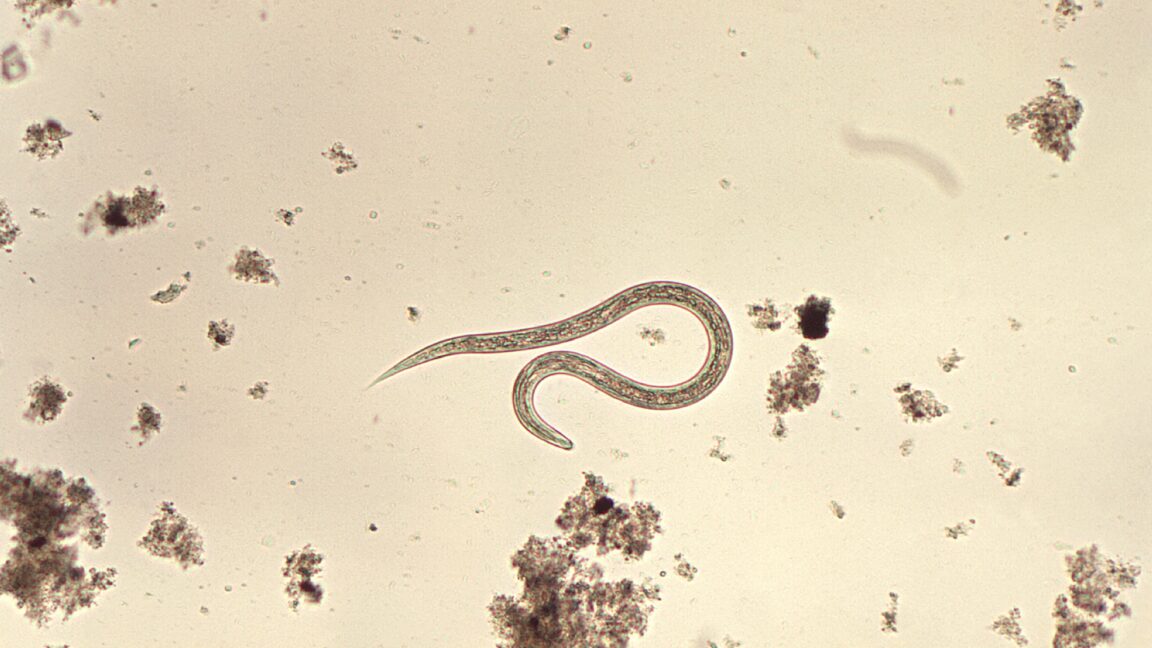arstechnica.com
Disgusting distraction Doctors find worms squirming through teens neck: A cautionary tale There are two charming categories of hookworms to keep in mind. Beth Mole Feb 21, 2025 9:04 am | 14 Magnified 100X, this whole mount photomicrograph revealed some of the ultrastructural morphology exhibited by a hookworm filariform larva. Image courtesy CDC/Dr. Mae Melvin, 1974. Credit: CDC Magnified 100X, this whole mount photomicrograph revealed some of the ultrastructural morphology exhibited by a hookworm filariform larva. Image courtesy CDC/Dr. Mae Melvin, 1974. Credit: CDC Story textSizeSmallStandardLargeWidth *StandardWideLinksStandardOrange* Subscribers only Learn moreRegardless of the state of the worldwhether you're staring down a Constitutional crisis or enjoying happier times, at ease on a beachit's wise to remember that there will always be tiny worms with gaping mouths ringed by razor-sharp teeth ready to pierce your body, burrow into your skin, and tunnel through your flesh like an ambitious gopher in springtime.I'm referring, of course, to hookworms, the blood-feeding parasites aptly named for the hook-like heads they use to latch onto their victims. In the US, they're most often found in international travelers. But, it's not out of the question that these petrifying parasites can strike on American soil, particularly in warm, moist areas. In a new clinical report in the New England Journal of Medicine, doctors in Los Angeles report just such a case, and a particularly unusual one at that.We still got emBut, before we get to the gruesome details, there are some things you should know about hookworms. As the Centers for Disease Control and Prevention notes, there are two delightful categories of these helminths. First, there are the ones that make it to your intestines after digging into your flesh and invading your organs. Once in your guts (your small intestine, to be specific), the worms live their best lives, maturing to adults, finding mates, and reproducing, all while sucking the life-blood out of you from the inside. They release their eggs into your poop to start this charming cycle anew in anyone whose skin is exposed to sewage-contaminated soil. Head of an adult of Ancylostoma caninum showing three pairs of teeth. Credit: CDC Head of an adult of Ancylostoma caninum showing three pairs of teeth. Credit: CDC These intestinal interlopers include Necator americanus and Ancylostoma duodenale, which are the leading hookworms worldwide, including in the US. There's also A. ceylanicum, which is emerging in many parts of the world but appears absent from North America and Europe (at least for now).In the early 20th century, the American South was crawling with intestinal hookworms. Some initial surveys in the 1930s suggested nearly 54 percent of the population was infected, with prevalence in some areas as high as 76 percent. Through concerted deworming efforts and improved hygiene, the worms were largely flushed out over the subsequent decades. But as one medical editorial put it in 2017: We still got 'em. That year, a study detected genetic traces of N. americanus in the stool of more than a third of people tested in an impoverished community in Lowndes County, Alabama. In Lowndes, approximately 50 percent of households have failing or no sewage systems.Creeping eruptionWhile that's something you can enjoy thinking about before bed tonight, let's not forget that there's a second category of hookworms: the ones that bore into your body but generally don't make it into your intestines. This may seem like the better scenario than the intestinal group. But, that's only the case if you're ok with hookworm larvae wandering aimlessly through the layers of your skin, leaving an intensely itchy, serpentine rash, marked by redness and little pus-filled blisters in their wake. The rash is called cutaneous larva migrans (CLM), or "creeping eruption."This second type of invasion is borne from worm-infested animals. The pack of parasites that cause CLM in people include hookworms that infect dogs and cats (Ancylostoma caninum, A. braziliense, and Uncinaria stenocephala), and in rarer cases cattle (Bunostomum phlebotomum).In animals, these hookworms live out a life cycle much like the intestinal cycle described earlier, with the parasites making themselves at home in the animals' small intestines. But, in humans, the worms find a dead-end. Most never make it out of the skin, roaming randomly until their death, which, without treatment, can take about five to six weeks. In their desperate meandering, some larvaewhich measure 500 to 600 micrometers (0.05 to 0.06 centimeters) longwill travel several centimeters each day. Others can make it into deeper tissue, but become stuck. On occasion, A. caninumwhich normally infect dogshave been known to make it to the intestines and partially develop. But they never complete their life cycle.Outbreaks and odditiesThese "extraintestinal" hookworms (as they're called in humans) pop up in the US from time to time. For instance, in July of 2006, health officials in Miami-Dade, Florida, discovered an outbreak of CLM at a summer camp, where 18 campers and four staff were ultimately found to be infected. The likely source, investigators concluded: a playground sandbox that some feral cats used as a litter box.In most cases, the rash from a wandering worm is in a foot, ankle, thigh, or rearbasically from a person walking or sitting in fecal-contaminated soil with exposed skin. But, in the New England Journal of Medicine report published in this week's issue, California doctors came across something unusual.A 19-year-old male came to a dermatology clinic with two winding, but non-itchy rashes on his neck, which had been there for three weeks. One was on the back of his neck while the other was on the right side. He had no recent international travel. A biopsy found non-specific inflammation. Another test was negative for fungal pathogens. The best clue to the causebesides the look of the rashwas that the teen told doctors he worked as a beach lifeguard and liked to lie in the sand. CLM on the back and side of the neck of a 19-year-old male. Credit: https://www.nejm.org/doi/full/10.1056/NEJMicm2414639 Despite the lack of itchiness and the higher location of the rash, the doctors concluded it was likely CLM from a hookworm, which he got from lying on a poopy beach. The standard treatment for CLM is ivermectin, an antiparasitic drug that still doesn't work against COVID-19 (despite what the new US health secretary has falsely claimed), but has proven useful against hookworms. After a two-day course of ivermectin, the teen's rash cleared up.While the case has a happy ending, it's a good reminder that one should never forget the horrifying hookworms.Beth MoleSenior Health ReporterBeth MoleSenior Health Reporter Beth is Ars Technicas Senior Health Reporter. Beth has a Ph.D. in microbiology from the University of North Carolina at Chapel Hill and attended the Science Communication program at the University of California, Santa Cruz. She specializes in covering infectious diseases, public health, and microbes. 14 Comments












